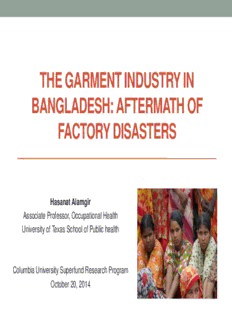
THE GARMENT INDUSTRY IN BANGLADESH: AFTERMATH OF FACTORY PDF
Preview THE GARMENT INDUSTRY IN BANGLADESH: AFTERMATH OF FACTORY
THE GARMENT INDUSTRY IN BANGLADESH: AFTERMATH OF FACTORY DISASTERS Hasanat Alamgir Associate Professor, Occupational Health University of Texas School of Public health Columbia University Superfund Research Program October 20, 2014 Outline I. Occupational Health II. Garment Industry of Bangladesh III. Baseline Survey by Alliance IV. Interventions by Alliance V. Rana Plaza Survivors Study VI. Employment for People with Disability Outline I. Occupational Health II. Garment Industry of Bangladesh III. Baseline Survey by Alliance IV. Interventions by Alliance V. Rana Plaza Survivors Study VI. Employment for people with disability ILO principle: workers should be protected from sickness, disease and injury arising from their employment. • 2 million die/year from work-related injuries/diseases • 160 million/year suffer from work-related diseases • 270 million/year sustain fatal and non-fatal work-related injuries 4% of world's GDP lost as consequence of occupational diseases/injuries Employers face costly early retirements, loss of skill, absenteeism, high insurance premiums….. Many are avoidable through implementation of prevention, reporting and inspection WHO Healthy Workplace Model A healthy workplace is “one in which workers and managers collaborate to use a continual improvement process to protect and promote health, safety and wellbeing of workers” Occupational Health aims at Promotion and maintenance of the highest degree of physical, mental and social well-being of workers Definition of occupational health adopted by the Joint ILO/WHO Committee on Occupational Health (1950) and revised in 1995 “The adaptation of work to man and of each man to his job” Globalization of Textile, Clothing & Footwear Sizeable employment losses in 60% world clothing exports are made in Europe/North America and gains in developing countries. Asia/developing world Asia-32%. China-13% A shift from formal to informal sector with First wave: Korea, Singapore, generally negative consequences on Hong Kong, Taiwan wage levels/conditions of work. Second wave: Philippines, Indonesia, Thailand, Malaysia From 1970 to 1990, TCF workers Third wave: Bangladesh, Pakistan, Increased Sri Lanka, Laos, Nepal, Viet Nam 597% in Malaysia; 416 % in Bangladesh; 385 % in Sri Lanka; 334 % US still employs 1.6 million workers, in Indonesia; 271 % in Philippines; and down from 2.5 million in 1980. 137% in Korea Decreased • Germany-58%; UK– 55%; France – ILO report, 1996 49%; and US- 31% Outline I. Occupational Health II. Garment Industry of Bangladesh III. Baseline Survey by Alliance IV. Interventions by Alliance V. Rana Plaza Victims Study VI. Employment for people with disability Garment Industry RMG started Critical to in late national 1970s. economy as Expected to Experienced Started a primary grow rapidly a real exporting in source of as China has impetus 1976 employment started to between and foreign divest 1980s- currency 1990s
Description: